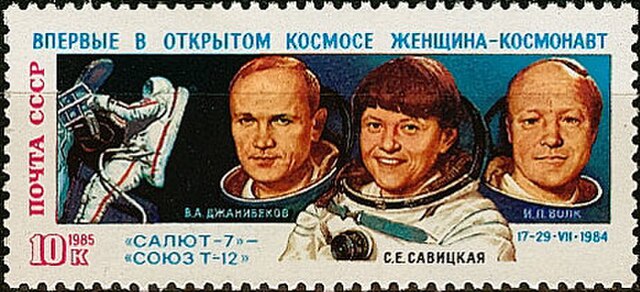The Buran programme, also known as the "VKK Space Orbiter programme", was a Soviet and later Russian reusable spacecraft project that began in 1974 at the Central Aerohydrodynamic Institute in Moscow and was formally suspended in 1993. In addition to being the designation for the whole Soviet/Russian reusable spacecraft project, Buran was also the name given to orbiter 1K, which completed one uncrewed spaceflight in 1988 and was the only Soviet reusable spacecraft to be launched into space. The Buran-class orbiters used the expendable Energia rocket as a launch vehicle.
The Antonov An-225 Mriya carrying a Buran orbiter in 1989.
Early artist's concept of a Soviet space shuttle approaching a manned space complex.
Igor Petrovich Volk, cosmonaut and test pilot of the OK-GLI.
The crew of Soyuz T-12 (Vladimir Dzhanibekov, Svetlana Savitskaya, and Igor Volk) on a stamp issued in 1985
Buran was the first spaceplane to be produced as part of the Soviet/Russian Buran program. Buran completed one uncrewed spaceflight in 1988, and was destroyed in 2002 due to the collapse of its storage hangar. The Buran-class orbiters used the expendable Energia rocket, a class of super heavy-lift launch vehicle. Besides describing the first operational Soviet/Russian shuttle orbiter, "Buran" was also the designation for the entire Soviet/Russian spaceplane project and its flight articles, which were known as "Buran-class orbiters".
Buran on An-225 at the 1989 Paris Air Show
Buran heat tiles visible on the OK-GLI aerotester, on display at the Technik Museum Speyer
Top of the Buran crew module, at the front of the ship, with the flight deck (Command Compartment - KO) visible through the payload bay windows.
Shuttle Buran docked to Mir using the docking module in the forward part of the payload bay (artist concept)








